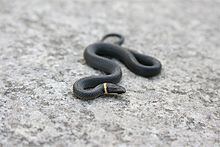Suborder Serpentes Subfamily Dipsadinae Phylum Chordata Rank Subspecies | Subphylum Vertebrata Genus Diadophis Higher classification Ring-necked snake Order Scaled reptiles | |
 | ||
Scientific name Diadophis punctatus edwardsii Similar Ring‑necked snake, Snake, Reptile, Northern redbelly snake, Storeria occipitomaculata | ||
Northern ringneck snake diadophis punctatus edwardsii
Diadophis punctatus edwardsii, commonly known as the Northern ringneck snake, is a subspecies of Diadophis punctatus. It is endemic to North America.
Contents
- Northern ringneck snake diadophis punctatus edwardsii
- Northern northern ring necked snake scientific name diadophis punctatus edwardsii release
- Etymology
- Description
- Geographic range
- Behavior
- Habitat
- Reproduction
- Diet
- Predation
- References
Northern northern ring necked snake scientific name diadophis punctatus edwardsii release
Etymology
The subspecific name, edwardsii, is in honor of English ornithologist George Edwards, who collected the type specimen.
Description
The Northern ringneck snake has a body color from bluish grey to black, with a complete narrow yellow or orange ring around its neck and an underside matching the ring and generally lacking any dark spotting or patterning. The complete ring and lack of large dark spots on the belly differentiate it from other subspecies of D. punctatus. In some regions, there are areas of intergradation with other subspecies. Generally from 10 to 15 inches (25 to 38 centimetres) long as an adult, they can reach more than two feet (61 cm) in length.
Geographic range
In Canada it is found in the southern parts of Ontario, Quebec, and New Brunswick, and also in Nova Scotia. In the United States it is found throughout New England, the Mid-Atlantic states, and the Great Lakes region, and also at higher elevations in the South. More specifically, it is found in the following: NE Alabama, Connecticut, NW Georgia, SE Illinois, S Indiana, Kentucky, W Maryland, Massachusetts, Michigan, NE Minnesota, N New Jersey, New York, W North Carolina, Ohio, Pennsylvania, Rhode Island, extreme NW South Carolina, E Tennessee, W (western) Virginia, West Virginia, Wisconsin, and Florida.
Behavior
The species is nocturnal and prone to hiding and traveling under rocks, fallen logs and leaf litter, so it is not commonly observed by people despite the potential abundant population density. (Another subspecies in Kansas was found to have densities of 700 to 1,800 per 1 hectare (0.0039 sq mi; 0.010 km2).) They are also social, and multiple ringnecks may be found in the same hiding spot during any season.
Habitat
Their favored habitat over most of their range is a moist wooded area, but they will also use the edges of wetlands or open areas in mountainous or hilly terrain. They are also often found in moist humid basements.
Reproduction
A female will lay her clutch of 2-10 eggs under a rock or in moist and rotting wood. Other female snakes may also use the same laying site, leading to single site egg finds of up to the mid fifties. The eggs hatch after about two months, and the young look essentially the same as the adults, possibly with a brighter color shade on the ring and belly. The eggs are 21–34 mm (3⁄4–1 1⁄4 in) long by 7–8 mm (1⁄4–1⁄4 in) wide, and the hatchlings are 100–125 mm (3.9–4.9 in) in total length. Egg laying is normally in early summer and hatching in late summer. In the winter, these snakes hibernate, in locations from stone walls or cellars to small mammal burrows to brush piles or rotting logs.
Diet
These snakes prey upon insects, salamanders, earthworms, slugs, small lizards, small snakes, and frogs. The red backed salamander is a favorite food.
Predation
They are themselves known to be preyed upon by bullfrogs, toads, five species of predatory birds and six mammal species including shrews. Very young Northern ringneck snakes may also be eaten by large centipedes or large spiders.
